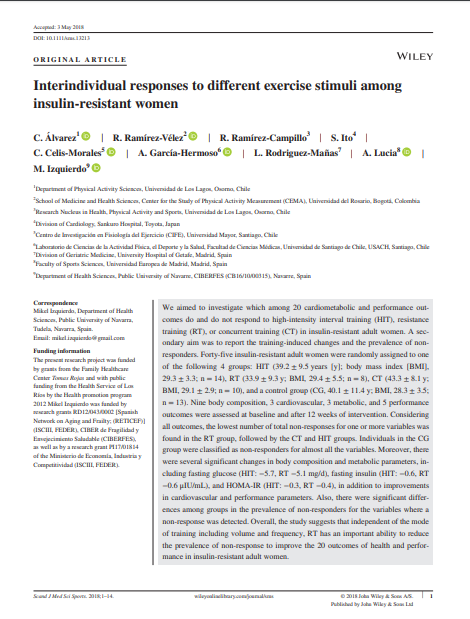Interindividual responses to different exercise stimuli among insulin-resistant women

Fecha
2018Autor
Celis-Morales, Carlos A. [Univ Mayor, CIFE, Santiago, Chile]
Alvarez, C.
Ramírez-Velez, R.
Ramírez-Campillo, R.
Ito, S.
García-Hermoso, A.
Rodríguez-Manas, L.
Lucia, A.
Izquierdo, M.
Ubicación geográfica
Notas
HERRAMIENTAS
Acceda a títulos restringidos
¿Cómo descargar?Resumen
We aimed to investigate which among 20 cardiometabolic and performance outcomes do and do not respond to high-intensity interval training (HIT), resistance training (RT), or concurrent training (CT) in insulin-resistant adult women. A secondary aim was to report the training-induced changes and the prevalence of non-responders. Forty-five insulin-resistant adult women were randomly assigned to one of the following 4 groups: HIT (39.2 +/- 9.5 years [y]; body mass index [BMI], 29.3 +/- 3.3; n= 14), RT (33.9 +/- 9.3 y; BMI, 29.4 +/- 5.5; n = 8), CT (43.3 +/- 8.1 y; BMI, 29.1 +/- 2.9; n = 10), and a control group (CG, 40.1 +/- 11.4 y; BMI, 28.3 +/- 3.5; n = 13). Nine body composition, 3 cardiovascular, 3 metabolic, and 5 performance outcomes were assessed at baseline and after 12 weeks of intervention. Considering all outcomes, the lowest number of total non-responses for one or more variables was found in the RT group, followed by the CT and HIT groups. Individuals in the CG group were classified as non-responders for almost all the variables. Moreover, there were several significant changes in body composition and metabolic parameters, including fasting glucose (HIT: -5.7, RT -5.1 mg/d), fasting insulin (HIT: -0.6, RT -0.6 mu IU/mL), and HOMA-IR (HIT: -0.3, RT -0.4), in addition to improvements in cardiovascular and performance parameters. Also, there were significant differences among groups in the prevalence of non-responders for the variables where a non-response was detected. Overall, the study suggests that independent of the mode of training including volume and frequency, RT has an important ability to reduce the prevalence of non-response to improve the 20 outcomes of health and performance in insulin-resistant adult women.
Coleccion/es a la/s que pertenece:
Si usted es autor(a) de este documento y NO desea que su publicación tenga acceso público en este repositorio, por favor complete el formulario aquí.